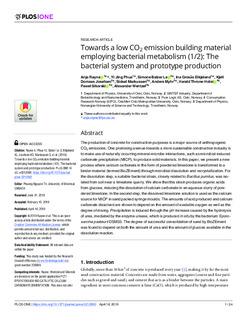| dc.contributor.author | Røyne, Anja | |
| dc.contributor.author | Phua, Yi Jing | |
| dc.contributor.author | Le, Simone Balzer | |
| dc.contributor.author | Eikjeland, Ina Grosås | |
| dc.contributor.author | Josefsen, Kjell Domaas | |
| dc.contributor.author | Markussen, Sidsel | |
| dc.contributor.author | Myhr, Anders | |
| dc.contributor.author | Throne-Holst, Harald | |
| dc.contributor.author | Sikorski, Pawel | |
| dc.contributor.author | Wentzel, Alexander | |
| dc.date.accessioned | 2019-04-25T07:49:06Z | |
| dc.date.available | 2019-04-25T07:49:06Z | |
| dc.date.created | 2019-04-23T14:07:10Z | |
| dc.date.issued | 2019 | |
| dc.identifier.citation | PLoS ONE. 2019, 14 (4), . | nb_NO |
| dc.identifier.issn | 1932-6203 | |
| dc.identifier.uri | http://hdl.handle.net/11250/2595378 | |
| dc.description.abstract | The production of concrete for construction purposes is a major source of anthropogenic CO2 emissions. One promising avenue towards a more sustainable construction industry is to make use of naturally occurring mineral-microbe interactions, such as microbial-induced carbonate precipitation (MICP), to produce solid materials. In this paper, we present a new process where calcium carbonate in the form of powdered limestone is transformed to a binder material (termed BioZEment) through microbial dissolution and recrystallization. For the dissolution step, a suitable bacterial strain, closely related to Bacillus pumilus, was isolated from soil near a limestone quarry. We show that this strain produces organic acids from glucose, inducing the dissolution of calcium carbonate in an aqueous slurry of powdered limestone. In the second step, the dissolved limestone solution is used as the calcium source for MICP in sand packed syringe moulds. The amounts of acid produced and calcium carbonate dissolved are shown to depend on the amount of available oxygen as well as the degree of mixing. Precipitation is induced through the pH increase caused by the hydrolysis of urea, mediated by the enzyme urease, which is produced in situ by the bacterium Sporosarcina pasteurii DSM33. The degree of successful consolidation of sand by BioZEment was found to depend on both the amount of urea and the amount of glucose available in the dissolution reaction. | nb_NO |
| dc.language.iso | eng | nb_NO |
| dc.publisher | Public Library of Science (PLOS) | nb_NO |
| dc.relation.uri | https://journals.plos.org/plosone/article?id=10.1371/journal.pone.0212990 | |
| dc.rights | Navngivelse 4.0 Internasjonal | * |
| dc.rights.uri | http://creativecommons.org/licenses/by/4.0/deed.no | * |
| dc.title | Towards a low CO2 emission building material employing bacterial metabolism (1/2): The bacterial system and prototype production | nb_NO |
| dc.type | Journal article | nb_NO |
| dc.type | Peer reviewed | nb_NO |
| dc.description.version | publishedVersion | nb_NO |
| dc.source.pagenumber | 24 | nb_NO |
| dc.source.volume | 14 | nb_NO |
| dc.source.journal | PLoS ONE | nb_NO |
| dc.source.issue | 4 | nb_NO |
| dc.identifier.doi | https://doi.org/10.1371/journal.pone.0212990 | |
| dc.identifier.cristin | 1693482 | |
| dc.relation.project | Norges forskningsråd: 238849 | nb_NO |
| dc.description.localcode | Open Access. Research accepted by PLOS journals is published under a CC BY license. Anyone may reuse the article with proper attribution. | nb_NO |
| cristin.unitcode | 194,66,20,0 | |
| cristin.unitname | Institutt for fysikk | |
| cristin.ispublished | true | |
| cristin.fulltext | original | |
| cristin.qualitycode | 1 | |

